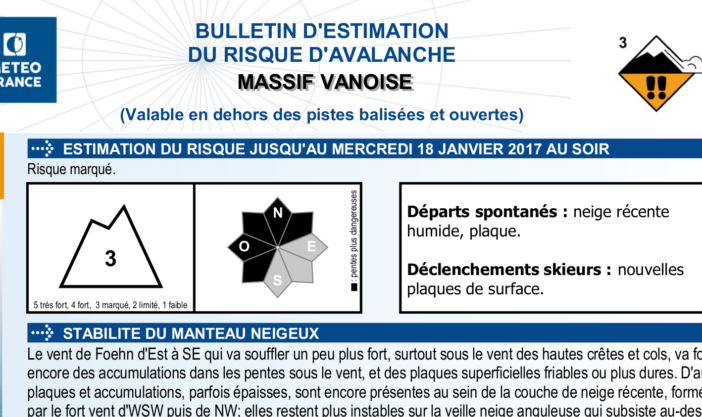
Reading and interpreting the avalanche forecast is fundamental to reducing the risk of becoming a victim of an avalanche.
Despite daily avalanche forecasts available on-line and displayed in ski resorts there are still too many avoidable avalanche accidents.
Studies show that these incidents took place where predicted by the avalanche forecast. So, either people are not reading the forecast, or if they do they are not extracting the information in it.
The Avalanche Risk Scale
The European avalanche risk scale runs from 1 to 5. Statistics (from France) for the last 15 years show that on 44% of days the risk was at level 2 (with 14% of fatal incidents) and 35% of days were level 3 (with 56% of fatal incidents).
One of the issues is the perception of Level 3. It is seen wrongly, by many as a ?medium? risk when in fact it is ?considerable?. If the avalanche risk scale e.g. 2 is the only element of the avalanche forecast being read incidents will clearly follow and the statistics would lend credence to this conclusion.
The Avalanche Forecast
The avalanche bulletin itself contains a wealth of information.
Timescale ? at the top it gives the validity of the forecast and the level of risk. Sometimes it indicates an altitude with one risk level below and another above.
Compass ? here it shows which slopes are the most dangerous in terms of their orientation.
Type of avalanche(s) to expect ? This is divided into two types, natural releases and those caused by skiers.
Snowpack Stability ? Here a detailed description of the current stability of the snowpack. It may give information about recent weather patterns including wind direction and strength. There may also be more detailed information about altitudes where certain risks may be higher. This paragraph should be read carefully.
Depth of Snow (at a certain altitude) ? here it gives information on the quantity of recent snowfalls and what is predicted over the following 48 hours.
Weather forecast summary ? here it gives the altitude of when rain will turn to snow; the freezing level and wind speed at different altitudes along with the direction.
Snow depth off-piste ? here it gives the depth of snow at different altitudes on both north and south facing slopes. It also gives the altitude from which you can expect continuous snow.
State of the snow ? the state of the snow e.g. is it crusted, humid or powder.
Avalanche risk outlook ? here it shows whether the risk is staying the same, increasing or decreasing.
Time when the forecast was written ? here it gives the date and time that the forecast was prepared.
As you can see there’s a wealth of information that when read carefully substantially decreases the chance of becoming an avalanche victim.


